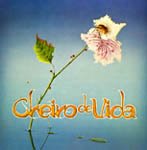
Clique aqui para baixar o disco/Download the album - RapidShare
Mais informações nos comentários / More info on comments
........................................................
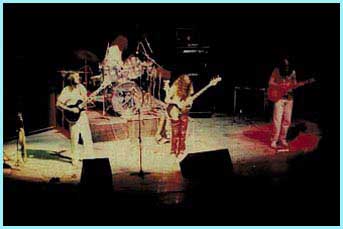 O Cheiro de Vida é composto por três grandes nomes da música instrumental do sul do Brasil: Alexandre Fonseca (bateria), André Gomes (baixo e sitar) e Carlos Martau (guitarra). Juntos formaram em 1978, em Porto Alegre, o lendário Cheiro de Vida, grupo instrumental de Jazz Rock progressivo. Na década de 80 foram para o Rio de Janeiro e rapidamente chamaram a atenção de nomes famosos do cenário musical do Brasil e desenvolveram trabalhos com artistas como Diana Pequeno, Pepeu Gomes, Marina Lima, Djavan, Nico Assumpção, entre outros.
O Cheiro de Vida é composto por três grandes nomes da música instrumental do sul do Brasil: Alexandre Fonseca (bateria), André Gomes (baixo e sitar) e Carlos Martau (guitarra). Juntos formaram em 1978, em Porto Alegre, o lendário Cheiro de Vida, grupo instrumental de Jazz Rock progressivo. Na década de 80 foram para o Rio de Janeiro e rapidamente chamaram a atenção de nomes famosos do cenário musical do Brasil e desenvolveram trabalhos com artistas como Diana Pequeno, Pepeu Gomes, Marina Lima, Djavan, Nico Assumpção, entre outros.Na Bagagem destes excelentes músicos, há muita esstória para contar: tours no exterior, participações especiais em estúdio e shows com vários artistas renomados, a fábrica de instrumentos de Martau... Como grupo, o Cheiro de Vida gravou dois álbuns históricos. O primeiro, em 1984, contou com participações de Paulo Supekóvia, Pedro Tagliani, Renato Alscher e Augusto Licks. O segundo álbum ao vivo (1988) contou com Dudu Trentin que participou do grupo por um período. Atualmente separados, André, Martau e Alex continuam sendo músicos altamente requisitados em estúdios e em shows por todo o país.
---------------------------
Gravada entre 1983 e 1984, a estréia do grupo gaúcho Cheiro de Vida tornou-se referência em todo o País para a música instrumental. Relançado em CD neste ano, o álbum registra o virtuosismo e o talento do quarteto distribuído entre o funk, o jazz e o rock progressivo, homenagens a Stanley Clarke, Hyeronymus Bosch e referências a "Nosferatu". Recheado de grandes momentos do guitarrista Carlos Martau e do baixista André Gomes, "Cheiro de Vida" é um grande disco, mesmo ouvido 15 anos depois do seu lançamento.
************************
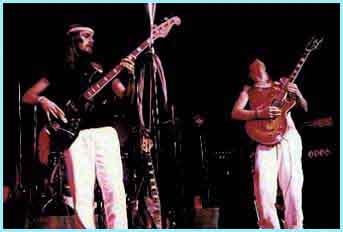 After some garage jams back in 1978, Cheiro de Vida was formed by bassist André Gomes, guitarist Carlos Martau and drummer Alexandre Fonseca.
After some garage jams back in 1978, Cheiro de Vida was formed by bassist André Gomes, guitarist Carlos Martau and drummer Alexandre Fonseca. The band started properly on 1980 on Rio Grande do Sul, south part of Brazil, performing on a variety of theaters and pubs, now with the addition of Paulo Supekovia also on guitar.
Moving to São Paulo in 1981, they recorded an album backing Brazilian singer Diana Pequeno, becoming her touring band, travelling all over the country.
At the end of 1982, the band came back to their hometown, Porto Alegre, and recorded for the second time, now with singer Bebeto Alves, on his live album titled “Notícia Urgente”. On the same year they also became the band for singer Victor Ramil besides keeping Cheiro de Vida’s own activities.
On the following year they began to record their first album “Cheiro de Vida”, which would only see the light of day a year later, on 1984. To finance the album, 850 “bonus” was sold to friends and fans. A couple of weeks before it’d start pressing the album, a small record label ACIT offered to take care of it’s promotion and distribution, in exchange of releasing it in it’s label. It was taken and proved a wrong business decision that took a long time to heal. After not receiving any royalties or proper promotion, the band took 10 years to get it’s masters back.
On the same year, Cheiro de Vida became a five-man band, with the addition of Dudu Trentin on keyboards. Things started happening writing and recording soundtracks for plays like “Cem Modos” a successful Theater Company that traveled around the country.
After that they decided it was time to move to Rio de Janeiro, and take their chances, and they all came to live together on the same apartment with their wives and kids, with the exception of Dudu Trentin which moved to Austria, where he started on his own later recording a solo album.
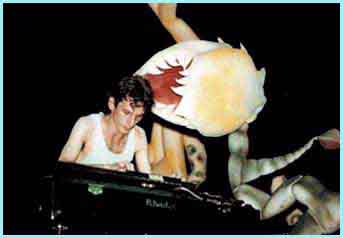 By 1987 the were a kind of back-up band for a night club called Jazzmania, the coolest place around for instrumental music, wherever it was a open slot, the band would come play, presenting their material. At this performances André Gomes also had a break for his sitar playing, showing another side of his abilities as a musician.
By 1987 the were a kind of back-up band for a night club called Jazzmania, the coolest place around for instrumental music, wherever it was a open slot, the band would come play, presenting their material. At this performances André Gomes also had a break for his sitar playing, showing another side of his abilities as a musician. After Jazzmania the word -of-mouth began to spread and soon started a special following by fans wherever they played. Some of Brazilian’s top musicians started popping around to check them out, such as Pepeu Gomes, Ricardo Silveria, Nico Assumpção, just to name a few and like others became friends with the band.
Cheiro de Vida had them started some few vocal numbers, like “Suave Mágica” and “Meninos” , having on André their vocalist. Warner Records became interested on recording them but with a budget of US$ 2,000 made it impossible to record properly. Instead a 6 song Demo tape was made on the “Nas Nuvens” studios, unreleased to this day.
With the need to make some money for their living, band members started to work with other artists. André and Alexandre were playing and recording for Pepeu Gomes and Martau was working with Marina on her “Virgem” album. Paulo Supekovia went back home to try pastures new and on 1988 Cheiro de Vida was back where they started just the Trio.
1988 started with a lot of concerts, beginning at Rio’s Planetário da Gávea, moving to Ipanema’s Theater before the band went to Porto Alegre for a couple of gigs at OASP, the first day to record the show for local TV station, and recording what was intended to be their second album “1988”.
Unable to release the album and with Martau joining Djavan on a world tour that went from USA to Japan, passing through Europe the band took a long break until 1991. With Dudu back on board they quickly started writing and playing with a new approach, more jazzy, and on 1992 began playing clubs again as well as recording what should be their second studio album, having Ricardo Silveira guesting on one track. Apart from a couple of unrecorded solos, the album was almost completed when the band took the present break.
Martau opened his “Guitar Clinic” becoming a much required luthier and also a very in demand live sound engineer as seen on his work with such artists as Frank Gambale, Mike Stern (which always asks for his service at once), Cássia Eller and nowadays Marina Lima.
André Gomes made some soundtracks after leaving Pepeu Gome’s Band, recorded an album with his father, violin player Zé Gomes, titled “A Idade dos Homens”, and also worked with pop-rap singer Gabriel O Pensador. Today his producing his wife, singer Hannah Lima.
Alexandre Fonseca after leaving Pepeu and playing with pop band Kid Abelha, can be found playing on teh industrial metal band “Infierno” as well as recording some tracks with Marcio Rocha’s Juno album.
Dudu Trentin just released a solo album entitled “Wherever I Go” and has his own website www.guiamarau.com.br/dudu.
The band is not over, their “expanding” and are seriously talking about a reunion to take place sometime in the near future.
To start the ball rolling their unreleased 1988 album was released in September/2000 and a couple more are in the cooking as you read this.
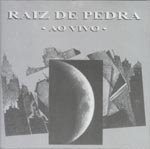
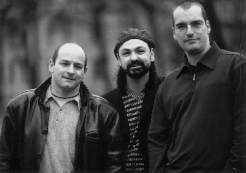 No início da década de 80, surgiu um dos mais importantes grupos de Porto Alegre, o Raiz de Pedra. Pedro Tagliani - violão e guitarra, Márcio Tubino - flauta e saxofones e César Audi - bateria criaram uma nova linguagem de Jazz progressivo que os tornaria conhecidos e respeitados por toda a Europa.
No início da década de 80, surgiu um dos mais importantes grupos de Porto Alegre, o Raiz de Pedra. Pedro Tagliani - violão e guitarra, Márcio Tubino - flauta e saxofones e César Audi - bateria criaram uma nova linguagem de Jazz progressivo que os tornaria conhecidos e respeitados por toda a Europa. Recorded live in 1987, this album presents one of the most interesting South American groups - the instrumental quintet Raiz De Pedra from Brazil. Although often referred to as a jazz group, they play a completely original type of music, with a lot of jazzy influences but very far from conventional jazz. In fact they are much closer to Rio groups, like Univers Zero, than to any mainstream jazz. Fronted by the excellent reeds and flute player Márcio Tubino, they play their “far out” music with ease and elegance. The compositions are very unconventional, with offbeat rhythms and tempos. The guitar and keyboards (when not soloing) often support the saxophone by creating layers of electronic sounds and the rhythm section (strengthened by a guest percussionist) provides a polyrhythmic drive. In short this is one of those uncanny albums that make your ears stand up when you hear it for the first time and tempt you to return to it time after time to really get it all. Warmly recommended.
Recorded live in 1987, this album presents one of the most interesting South American groups - the instrumental quintet Raiz De Pedra from Brazil. Although often referred to as a jazz group, they play a completely original type of music, with a lot of jazzy influences but very far from conventional jazz. In fact they are much closer to Rio groups, like Univers Zero, than to any mainstream jazz. Fronted by the excellent reeds and flute player Márcio Tubino, they play their “far out” music with ease and elegance. The compositions are very unconventional, with offbeat rhythms and tempos. The guitar and keyboards (when not soloing) often support the saxophone by creating layers of electronic sounds and the rhythm section (strengthened by a guest percussionist) provides a polyrhythmic drive. In short this is one of those uncanny albums that make your ears stand up when you hear it for the first time and tempt you to return to it time after time to really get it all. Warmly recommended.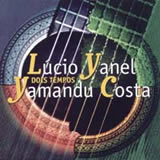
 Nascido em Passo Fundo em 1980, Yamandu começou a estudar violão aos 7 anos de idade com o pai, Algacir Costa, líder do grupo “Os Fronteiriços” e aprimorou-se com Lúcio Yanel, virtuoso argentino radicado no Brasil.
Nascido em Passo Fundo em 1980, Yamandu começou a estudar violão aos 7 anos de idade com o pai, Algacir Costa, líder do grupo “Os Fronteiriços” e aprimorou-se com Lúcio Yanel, virtuoso argentino radicado no Brasil. 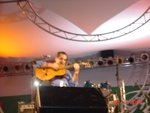 Este álbum foi gravado no início de 2001. Yamandu derrama virtuosismo ao lado de seu professor, o igualmente fantástico Lúcio Yanel. Os dois músicos interpretam obras de Yanel, como o tango "Dois Tempos" e a polca "Amazônia", um tema de Yamandu, o choro "Cristal", e composições de nomes como Dilermando Reis (o choro "Dr. Sabe Tudo"), Ernesto Nazareth (o choro "Brejeiro") e Radamés Gnatalli (o samba "Brasiliana"), além de um pout-pourri com as zambas "El Paraná En Una Zamba", de Ariel Ramirez, e "Zamba Del Grillo", de Atahualpa Yupanqui). Uma verdadeira aula musical.
Este álbum foi gravado no início de 2001. Yamandu derrama virtuosismo ao lado de seu professor, o igualmente fantástico Lúcio Yanel. Os dois músicos interpretam obras de Yanel, como o tango "Dois Tempos" e a polca "Amazônia", um tema de Yamandu, o choro "Cristal", e composições de nomes como Dilermando Reis (o choro "Dr. Sabe Tudo"), Ernesto Nazareth (o choro "Brejeiro") e Radamés Gnatalli (o samba "Brasiliana"), além de um pout-pourri com as zambas "El Paraná En Una Zamba", de Ariel Ramirez, e "Zamba Del Grillo", de Atahualpa Yupanqui). Uma verdadeira aula musical.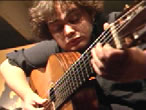 One of the greatest geniuses of Brazilian music of all times, young Yamandu deserves the highest praise. Whenever he is on stage, he fills with joy the most select audience since his impressive performance shows the deep intimacy between Yamandu and his guitar. The recognition he has earned throughout the years reveals what he can offer the audience – recreation of the magic of music - once from his fingers the music he plays travels through his body and soul and is almost miraculously transformed.
One of the greatest geniuses of Brazilian music of all times, young Yamandu deserves the highest praise. Whenever he is on stage, he fills with joy the most select audience since his impressive performance shows the deep intimacy between Yamandu and his guitar. The recognition he has earned throughout the years reveals what he can offer the audience – recreation of the magic of music - once from his fingers the music he plays travels through his body and soul and is almost miraculously transformed.
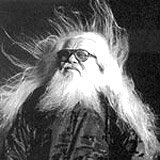 Hermeto Pascoal nasceu em Lagoa da Canoa, município de Arapiraca, Alagoas, no dia 22 de junho de 1936. Ele foi um prodígio musical: ele começou com a flauta e aos oito anos já tocava sanfona. Com onze anos ele estava tocando nos bailes e forrós em torno da região de Arapiraca.
Hermeto Pascoal nasceu em Lagoa da Canoa, município de Arapiraca, Alagoas, no dia 22 de junho de 1936. Ele foi um prodígio musical: ele começou com a flauta e aos oito anos já tocava sanfona. Com onze anos ele estava tocando nos bailes e forrós em torno da região de Arapiraca. 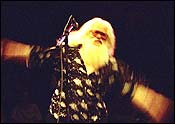 Enquanto esteve nos Estados Unidos, o multi-instrumentista pode apresentar suas extraordinárias habilidades como improvisador em concertos, e suas composições originais e idiossincráticas. Teve sua obra gravada por vários artistas, entre eles, Gil Evans e a Sinfônica de Berlin.
Enquanto esteve nos Estados Unidos, o multi-instrumentista pode apresentar suas extraordinárias habilidades como improvisador em concertos, e suas composições originais e idiossincráticas. Teve sua obra gravada por vários artistas, entre eles, Gil Evans e a Sinfônica de Berlin. 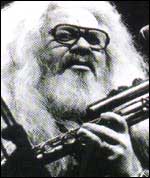 At 14 years old he made his debut with his brother José Neto on the Tamandaré radio station in Recife. In 1956 he returned to Radio Jornal do Comércio where he had been before for a short time. He got to be regional director. In 1958 he went to Paraíba where he joined Radio Tabajara in João Pessoa city and he began to perform in Maestro Gomes orchestra. He made himself distinctive as an instrumentalist playing in the orchestra despite not being able to read music. Also in 1958 he went to Radio Mauá in Rio de Janeiro, he was an accordion player in the Regional de Pernambuco do Pandeiro. He also was in the Fafá Lemos and Copinha groups. He began to dedicate himself to studying the piano and he played in the evening.
At 14 years old he made his debut with his brother José Neto on the Tamandaré radio station in Recife. In 1956 he returned to Radio Jornal do Comércio where he had been before for a short time. He got to be regional director. In 1958 he went to Paraíba where he joined Radio Tabajara in João Pessoa city and he began to perform in Maestro Gomes orchestra. He made himself distinctive as an instrumentalist playing in the orchestra despite not being able to read music. Also in 1958 he went to Radio Mauá in Rio de Janeiro, he was an accordion player in the Regional de Pernambuco do Pandeiro. He also was in the Fafá Lemos and Copinha groups. He began to dedicate himself to studying the piano and he played in the evening. 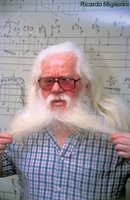 In 1972 he received the best solo player award. In 1973 he recorded his first record in Brazil A música livre de Hermeto Pascoal where he again surprised everybody with his innovations. On the track Serei rei the recording crew needed to go to a farm and Hermeto played in the middle of hogs, hens, geese and turkeys. In 1973 he received the best arranger award. In 1975 he performed at TV Globo’s Abertura Festival where he interpreted the composition Porco na festa which he received the best arrangement award. In 1977 he recorded his third record Missa dos escravos in the United States.
In 1972 he received the best solo player award. In 1973 he recorded his first record in Brazil A música livre de Hermeto Pascoal where he again surprised everybody with his innovations. On the track Serei rei the recording crew needed to go to a farm and Hermeto played in the middle of hogs, hens, geese and turkeys. In 1973 he received the best arranger award. In 1975 he performed at TV Globo’s Abertura Festival where he interpreted the composition Porco na festa which he received the best arrangement award. In 1977 he recorded his third record Missa dos escravos in the United States. 
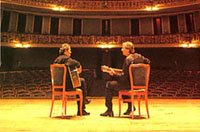 Desde que se conheceram em São Paulo, em 1977, Luiz Bueno e Fernando Melo vêm pesquisando e experimentando a música brasileira. Tocaram na banda de rock progressivo A Boissucanga (Luiz na guitarra e Fernando no baixo) e, insatisfeitos, começaram a compor juntos para o formato de um duo de violões.
Desde que se conheceram em São Paulo, em 1977, Luiz Bueno e Fernando Melo vêm pesquisando e experimentando a música brasileira. Tocaram na banda de rock progressivo A Boissucanga (Luiz na guitarra e Fernando no baixo) e, insatisfeitos, começaram a compor juntos para o formato de um duo de violões. 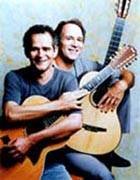 "Antes de Kids of Brazil, nós nos considerávamos voltados para a música pop. As harmonias não eram muito trabalhadas, os acordes eram mais naturais. Quando abríamos os concertos do Hermeto como convidados, ficávamos ligados em sua música o show inteiro. Sem percebermos, acabamos bebendo dessa fonte. As músicas dele entraram em nosso subconsciente. Quando fomos compor novas músicas, começaram a surgir composições diferentes, com outras harmonias e melodias. Mostramos para o Hermeto o trabalho novo e ele se entusiasmou: “vou fazer arranjos para vocês. Sei onde vocês querem chegar e vou mostrar o caminho”. Ele mostrou notas que faltavam em acordes e melodias. E nós começamos a descobrir novas afinações no violão para poder tocar os arranjos criados por ele. Kids of Brazil ficou diferente de tudo o que a gente já tinha feito. É um disco difícil em termos comerciais, mas é um de nossos melhores trabalhos."
"Antes de Kids of Brazil, nós nos considerávamos voltados para a música pop. As harmonias não eram muito trabalhadas, os acordes eram mais naturais. Quando abríamos os concertos do Hermeto como convidados, ficávamos ligados em sua música o show inteiro. Sem percebermos, acabamos bebendo dessa fonte. As músicas dele entraram em nosso subconsciente. Quando fomos compor novas músicas, começaram a surgir composições diferentes, com outras harmonias e melodias. Mostramos para o Hermeto o trabalho novo e ele se entusiasmou: “vou fazer arranjos para vocês. Sei onde vocês querem chegar e vou mostrar o caminho”. Ele mostrou notas que faltavam em acordes e melodias. E nós começamos a descobrir novas afinações no violão para poder tocar os arranjos criados por ele. Kids of Brazil ficou diferente de tudo o que a gente já tinha feito. É um disco difícil em termos comerciais, mas é um de nossos melhores trabalhos."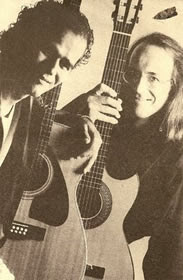 "Virtuosismo, interação sensível e um potencial inesgotável: "Sem nenhuma dúvida, o DUOFEL faz a nova música instrumental do Brasil."
"Virtuosismo, interação sensível e um potencial inesgotável: "Sem nenhuma dúvida, o DUOFEL faz a nova música instrumental do Brasil."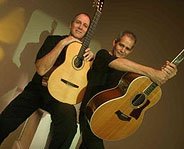 Since they met in São Paulo, in 1977, Luiz Bueno and Fernando Melo have been researching and experimenting with Brazilian music. They played in the progressive rock band, A Boissucanga (Luiz on the guitar and Fernando on the bass) and, dissatisfied, they began to compose together for a guitar duet.
Since they met in São Paulo, in 1977, Luiz Bueno and Fernando Melo have been researching and experimenting with Brazilian music. They played in the progressive rock band, A Boissucanga (Luiz on the guitar and Fernando on the bass) and, dissatisfied, they began to compose together for a guitar duet.
 O primeiro, "Grupo Medusa", lançado em 1981, inaugurou a gravadora Som da Gente, especializada em discos de música instrumental brasileira. A formação do grupo, nesse disco, era: Amilson Godoy (piano), Cláudio Bertrami (baixo), Heraldo do Monte (guitarra, violão, bandolim) e Chico Medori (bateria), com participações de Theo da Cuíca e Jorginho Cebion na percussão. Um álbum inovador, composto por músicas autorais, com bastante espaço para improvisos de todos os músicos, altamente melódico e rico na exploração dos ritmos brasileiros.
O primeiro, "Grupo Medusa", lançado em 1981, inaugurou a gravadora Som da Gente, especializada em discos de música instrumental brasileira. A formação do grupo, nesse disco, era: Amilson Godoy (piano), Cláudio Bertrami (baixo), Heraldo do Monte (guitarra, violão, bandolim) e Chico Medori (bateria), com participações de Theo da Cuíca e Jorginho Cebion na percussão. Um álbum inovador, composto por músicas autorais, com bastante espaço para improvisos de todos os músicos, altamente melódico e rico na exploração dos ritmos brasileiros.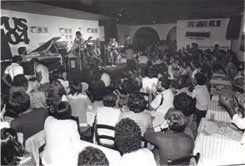 The first one, "Grupo Medusa", released in 1981, inaugurated the record company Som da Gente, specialized in Brazilian instrumental music. The line-up in this record, was: Amilson Godoy (piano), Cláudio Bertrami (bass), Heraldo do Monte (electric and acoustic guitar, mandolin) and Chico Medori (drums), with guest appearence of Theo da Cuíca and Jorginho Cebion on percussion. An innovative and authorial album, with lots of spaces for improvisation of all the musicians, and highly rich in the exploration of the Brazilian rhythms.
The first one, "Grupo Medusa", released in 1981, inaugurated the record company Som da Gente, specialized in Brazilian instrumental music. The line-up in this record, was: Amilson Godoy (piano), Cláudio Bertrami (bass), Heraldo do Monte (electric and acoustic guitar, mandolin) and Chico Medori (drums), with guest appearence of Theo da Cuíca and Jorginho Cebion on percussion. An innovative and authorial album, with lots of spaces for improvisation of all the musicians, and highly rich in the exploration of the Brazilian rhythms.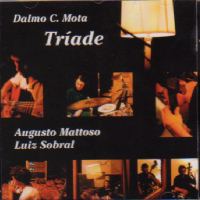
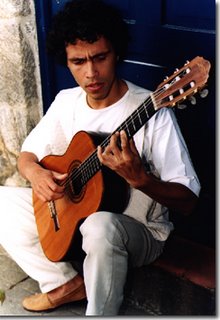 Formado no segundo semestre do ano de 1991 pelo violonista, compositor e arranjador Dalmo C. Mota, em parceria com o contrabaixista Augusto Mattoso e o baterista Luiz Sobral, o grupo reúne as experiências diferenciadas dos integrantes explorando as possibilidades expressivas da formação de trio.
Formado no segundo semestre do ano de 1991 pelo violonista, compositor e arranjador Dalmo C. Mota, em parceria com o contrabaixista Augusto Mattoso e o baterista Luiz Sobral, o grupo reúne as experiências diferenciadas dos integrantes explorando as possibilidades expressivas da formação de trio.
 A Banda Black Rio surgiu durante a segunda metade da década de 70. Havia um movimento natural que surgia então: musicalmente ligava o soul ao samba, mas não foi um movimento restrito à música. Tinha uma variedade de nomes: Black Power, Soul Power, e o mais famoso, Black Rio. Os nomes estão em inglês porque a idéia era fundir as línguas, quebrar o individualismo, abrir espaços, e confrontar os puristas.
A Banda Black Rio surgiu durante a segunda metade da década de 70. Havia um movimento natural que surgia então: musicalmente ligava o soul ao samba, mas não foi um movimento restrito à música. Tinha uma variedade de nomes: Black Power, Soul Power, e o mais famoso, Black Rio. Os nomes estão em inglês porque a idéia era fundir as línguas, quebrar o individualismo, abrir espaços, e confrontar os puristas.  Muito influenciado por Pixinguinha como por Coleman Hawkins, grande admirador de Cartola e Stevie Wonder, levou adiante seus planos de fusão musical para os night-clubs do Rio, onde começou a tocar aos 15 anos de idade. Estudante de Paulo Moura, grande mestre brasileiro do saxofone, ingressou no grupo Impacto 8, onde começou a delinear o que mais tarde se tornaria o som da Banda Black Rio. No Impacto 8, Oberdan reuniu músicos como Raul de Souza e o baterista Robertinho Silva, tocando uma mistura, ainda na sua fase inicial, de soul, jazz e samba. A partir daí juntou-se ao pianista Dom Salvador e o grupo Abolição, onde conheceu alguns dos músicos que fizeram parte da primeira formação da Banda Black Rio, como o trompetista Barrosinho, o trombonista Lúcio e o baterista Luis Carlos. Entre shows e sessões de gravação, conheceu o guitarrista Cláudio Stevenson, o baixista Jamil Joanes e o pianista Cristóvão Bastos. Foram com esses músicos que ele formou o grupo Rio 40º.
Muito influenciado por Pixinguinha como por Coleman Hawkins, grande admirador de Cartola e Stevie Wonder, levou adiante seus planos de fusão musical para os night-clubs do Rio, onde começou a tocar aos 15 anos de idade. Estudante de Paulo Moura, grande mestre brasileiro do saxofone, ingressou no grupo Impacto 8, onde começou a delinear o que mais tarde se tornaria o som da Banda Black Rio. No Impacto 8, Oberdan reuniu músicos como Raul de Souza e o baterista Robertinho Silva, tocando uma mistura, ainda na sua fase inicial, de soul, jazz e samba. A partir daí juntou-se ao pianista Dom Salvador e o grupo Abolição, onde conheceu alguns dos músicos que fizeram parte da primeira formação da Banda Black Rio, como o trompetista Barrosinho, o trombonista Lúcio e o baterista Luis Carlos. Entre shows e sessões de gravação, conheceu o guitarrista Cláudio Stevenson, o baixista Jamil Joanes e o pianista Cristóvão Bastos. Foram com esses músicos que ele formou o grupo Rio 40º. A banda continuou fazendo shows no início da década de 80. Teve, porém, uma repentina interrupção devido a morte de Oberdan em um acidente de carro em 1984. Devido a esta interrupção, a banda ficou fora de atividade e só voltou depois de 15 anos através do filho de Oberdan, William Magalhães, pianista, tecladista, arranjador e produtor que trabalhou com vários artistas como, Gilberto Gil, Caetano Veloso, Gal Costa, Ed Motta, Marina Lima, Cláudio Zolli, Cassiano, Sandra de Sá, Milton Nascimento, entre outros. William iniciou seus estudos aos 7 anos e cresceu em um ambiente extremamente musical onde não só frequentava os ensaios de seu pai como também participava das serestas de sua vó Yolanda, os ensaios da escola de samba do Império Serrano onde sua família participava ativamente e os almoços de domingo na Serrinha na casa de sua Tia Maria onde se preserva até hoje a tradição do jongo. Na adolescência estudou jazz e foi aluno da pianista Sonia Vieira e aos 18 anos começou a tocar com Gilberto Gil participando de várias tournees internacionais. Em 1996 foi premiado pela APCA como melhor arranjador, pelo seu trabalho realizado no disco “Registros à Meia–Voz” de Marina Lima. Ainda na da década de 90, William começou a pesquisar o trabalho da Banda Black Rio e estudou os esboços e as poucas partituras deixadas por seu pai. Os arranjos de metais e as batidas que misturavam samba com outros ritmos sempre foram a marca registrada desta banda. Em 1999 a banda estava montada novamente e então gravaram o disco entitulado “Movimento” em 2001 pelo selo Regata e foi premiada como melhor banda pop rock em 2002 pelo prêmio Caras – antigo prêmio Sharp. Este disco foi lançado em Londres pelo selo Mr. Bongo em dezembro de 2002 com algumas faixas remixadas por grandes nomes da música Londrina, como Fase Action, entre outros. O título deste CD na Inglaterra é “Rebirth”, que traduz precisamente este momento de renascimento.
A banda continuou fazendo shows no início da década de 80. Teve, porém, uma repentina interrupção devido a morte de Oberdan em um acidente de carro em 1984. Devido a esta interrupção, a banda ficou fora de atividade e só voltou depois de 15 anos através do filho de Oberdan, William Magalhães, pianista, tecladista, arranjador e produtor que trabalhou com vários artistas como, Gilberto Gil, Caetano Veloso, Gal Costa, Ed Motta, Marina Lima, Cláudio Zolli, Cassiano, Sandra de Sá, Milton Nascimento, entre outros. William iniciou seus estudos aos 7 anos e cresceu em um ambiente extremamente musical onde não só frequentava os ensaios de seu pai como também participava das serestas de sua vó Yolanda, os ensaios da escola de samba do Império Serrano onde sua família participava ativamente e os almoços de domingo na Serrinha na casa de sua Tia Maria onde se preserva até hoje a tradição do jongo. Na adolescência estudou jazz e foi aluno da pianista Sonia Vieira e aos 18 anos começou a tocar com Gilberto Gil participando de várias tournees internacionais. Em 1996 foi premiado pela APCA como melhor arranjador, pelo seu trabalho realizado no disco “Registros à Meia–Voz” de Marina Lima. Ainda na da década de 90, William começou a pesquisar o trabalho da Banda Black Rio e estudou os esboços e as poucas partituras deixadas por seu pai. Os arranjos de metais e as batidas que misturavam samba com outros ritmos sempre foram a marca registrada desta banda. Em 1999 a banda estava montada novamente e então gravaram o disco entitulado “Movimento” em 2001 pelo selo Regata e foi premiada como melhor banda pop rock em 2002 pelo prêmio Caras – antigo prêmio Sharp. Este disco foi lançado em Londres pelo selo Mr. Bongo em dezembro de 2002 com algumas faixas remixadas por grandes nomes da música Londrina, como Fase Action, entre outros. O título deste CD na Inglaterra é “Rebirth”, que traduz precisamente este momento de renascimento. Banda Black Rio was created in 1976. At this time there was a natural movement coming: musically it linked soul to samba, but it was not a movement restricted just to music. It had a variety of names: Black Power, Soul Power, and the most famous one, Black Rio. The names are in English, because the idea was to fuse languages, to break down individualism, to open up gaps, to confront the purists.
Banda Black Rio was created in 1976. At this time there was a natural movement coming: musically it linked soul to samba, but it was not a movement restricted just to music. It had a variety of names: Black Power, Soul Power, and the most famous one, Black Rio. The names are in English, because the idea was to fuse languages, to break down individualism, to open up gaps, to confront the purists. At this time, WEA had just been established in Brazil, and they wanted to create a band which could be the pioneer of this movement; so they contacted Oberdan Magalhães, a renowned saxophonist, that accepted the challenge and formed Banda Black Rio. Born and brought up in Madureira (an area of the Zona Norte), he was the cousin of Silas de Oliveira, (the great composer of many sambas enredo and one of the founders of the Escola de Samba of the Império Serrano) and the godson of Mano Décio da Viola (another great name of the escola), he had the tradition of samba in his family but other musical background too.
At this time, WEA had just been established in Brazil, and they wanted to create a band which could be the pioneer of this movement; so they contacted Oberdan Magalhães, a renowned saxophonist, that accepted the challenge and formed Banda Black Rio. Born and brought up in Madureira (an area of the Zona Norte), he was the cousin of Silas de Oliveira, (the great composer of many sambas enredo and one of the founders of the Escola de Samba of the Império Serrano) and the godson of Mano Décio da Viola (another great name of the escola), he had the tradition of samba in his family but other musical background too. These albums and songs continued to be played in Europe, specially in the UK, Germany and also in Japan. After about fifteen years, in 1999, the band’s activities were retaken by his elder son, William Magalhães, a pianist, arranger and producer that has worked with various artists such as Gilberto Gil, Caetano Veloso, Gal Costa, Ed Motta, Marina Lima, Cláuido Zolli, Cassiano, Sandra de Sá, Milton Nascimento, and others. William started studying music at the age of seven and was brought up in an extremelly musical environment where he not only attended to his father’s rehearsals but also took part in the serestas (musical events where musicians are invited to play traditional brazilian music such as chorinho, sambas and bossa-nova) of his grandmother Yolanda, the rehearsals of the escola de samba of the Império Serrano, where his family actively participated and the Sunday lunches in Serrinha at his aunt´s house, Tia Maria, where it is preserved till today the tradition of the jongo – a pure african dance. During his adolescence he studied jazz and was a student of the pianist Sonia Vieira and at the age of 18 started to play with Gilberto Gil, taking part of many international tournees. In 1996 he won the APCA prize of best arranger, for his work on the album ‘Registros à Meia-Voz’ of Marina Lima. Still in the 90’s, William started to research the musical work of Banda Black Rio and studied the few musical pieces left by his father. The horn arranegements and the grooves that mixed samba with other rithms were always the trademark of this band. In 1999, William invited musicians to join the new band and brought the first trombonist of the band, Lúcio Silva, back again. The album “Movimento” was recorded in 2001 and won the prize of the best pop-rock band by the Prêmio Caras. This album was released in the UK with the title ‘Rebirth’ by Mr. Bongo records in 2002 with some tracks remixed by Fase Action and others. The title of this album translates precisely this moment of renewal.
These albums and songs continued to be played in Europe, specially in the UK, Germany and also in Japan. After about fifteen years, in 1999, the band’s activities were retaken by his elder son, William Magalhães, a pianist, arranger and producer that has worked with various artists such as Gilberto Gil, Caetano Veloso, Gal Costa, Ed Motta, Marina Lima, Cláuido Zolli, Cassiano, Sandra de Sá, Milton Nascimento, and others. William started studying music at the age of seven and was brought up in an extremelly musical environment where he not only attended to his father’s rehearsals but also took part in the serestas (musical events where musicians are invited to play traditional brazilian music such as chorinho, sambas and bossa-nova) of his grandmother Yolanda, the rehearsals of the escola de samba of the Império Serrano, where his family actively participated and the Sunday lunches in Serrinha at his aunt´s house, Tia Maria, where it is preserved till today the tradition of the jongo – a pure african dance. During his adolescence he studied jazz and was a student of the pianist Sonia Vieira and at the age of 18 started to play with Gilberto Gil, taking part of many international tournees. In 1996 he won the APCA prize of best arranger, for his work on the album ‘Registros à Meia-Voz’ of Marina Lima. Still in the 90’s, William started to research the musical work of Banda Black Rio and studied the few musical pieces left by his father. The horn arranegements and the grooves that mixed samba with other rithms were always the trademark of this band. In 1999, William invited musicians to join the new band and brought the first trombonist of the band, Lúcio Silva, back again. The album “Movimento” was recorded in 2001 and won the prize of the best pop-rock band by the Prêmio Caras. This album was released in the UK with the title ‘Rebirth’ by Mr. Bongo records in 2002 with some tracks remixed by Fase Action and others. The title of this album translates precisely this moment of renewal.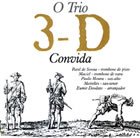
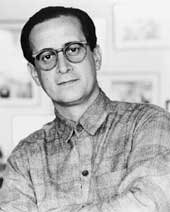 Fruto da “febre dos trios” característica da segunda fase da bossa nova, quando uma geração de instrumentistas da mais alta impedância e estirpe passou a reinar no Beco das Garrafas, em contraponto estético à leveza da bossa “peso-pluma” (nas palavras de Ruy Castro) de Jobim, Bonfá & João Gilberto, o Trio 3D representou um marco na carreira de seu fundador, o carioca Antonio Adolfo Maurity Sabóia. Nascido em 10 de fevereiro de 1947, estudou no Conservatório de Música Lorenzo Fernandes, passando a frequentar o Bottle’s Bar e o Little Club a partir de 1963, integrando o grupo Samba Cinco.
Fruto da “febre dos trios” característica da segunda fase da bossa nova, quando uma geração de instrumentistas da mais alta impedância e estirpe passou a reinar no Beco das Garrafas, em contraponto estético à leveza da bossa “peso-pluma” (nas palavras de Ruy Castro) de Jobim, Bonfá & João Gilberto, o Trio 3D representou um marco na carreira de seu fundador, o carioca Antonio Adolfo Maurity Sabóia. Nascido em 10 de fevereiro de 1947, estudou no Conservatório de Música Lorenzo Fernandes, passando a frequentar o Bottle’s Bar e o Little Club a partir de 1963, integrando o grupo Samba Cinco. Os convidados surgem nas faixas do “lado B”. Edson Maciel desliza seu trombone de vara, pela bela melodia de “Primavera” (Carlos Lyra), em atmosfera de intenso lirismo mas nada açucarada, enquanto Raul de Souza, que três meses antes havia lançado seu disco-solo “À Vontade Mesmo” pela RCA, conta “um, dois, três” antes de esbaldar-se no trombone de válvula em “Bye Bye Blackbird”, aprontando solo de estonteante fluência. Meirelles (líder do Copa 5) mostra sua classe no sax-tenor no sambop “Tema 3D”, única composição de Adolfo incluida no repertório. E Paulo Moura, no sax-alto, destrincha “O Passarinho”, obscura parceria de Chico Feitosa & Lula Freire, encaixando explícita referência a “Take Five”.
Os convidados surgem nas faixas do “lado B”. Edson Maciel desliza seu trombone de vara, pela bela melodia de “Primavera” (Carlos Lyra), em atmosfera de intenso lirismo mas nada açucarada, enquanto Raul de Souza, que três meses antes havia lançado seu disco-solo “À Vontade Mesmo” pela RCA, conta “um, dois, três” antes de esbaldar-se no trombone de válvula em “Bye Bye Blackbird”, aprontando solo de estonteante fluência. Meirelles (líder do Copa 5) mostra sua classe no sax-tenor no sambop “Tema 3D”, única composição de Adolfo incluida no repertório. E Paulo Moura, no sax-alto, destrincha “O Passarinho”, obscura parceria de Chico Feitosa & Lula Freire, encaixando explícita referência a “Take Five”.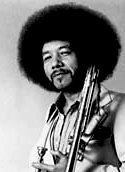 When people think of Brazilian jazz in the '60s, the first thing that comes to mind is bossa nova — a caressing, subtle, laidback blend of cool jazz and samba. But not all of the Brazilian jazz from that decade is bossa nova. Some Brazilian improvisers were influenced by the more aggressive and extroverted sounds of hard bop. They respected Stan Getz' legendary work with João Gilberto and Antonio Carlos Jobim, but they preferred a tougher, more hard-swinging style of Brazilian jazz. They identified with the forcefulness of Phil Woods, Cannonball Adderley, Horace Silver, and Art Blakey's Jazz Messengers, rather than the subtle introspection of Chet Baker and Lee Konitz. In the '60s, Brazil's hard boppers included trombonist Raul de Souza and 3-D, which consisted of pianist Antonio Adolfo, bassist Carlos Monjardin, and drummer Nelson Serra De Castro. Raul de Souza isn't actually the leader on Convida; this is really a 3-D album, and Raul de Souza is among the guest soloists (who also include tenor saxman J.T. Meirelles, and alto saxman Paulo Moura). But because the underexposed Raul de Souza hasn't recorded nearly as often as he should have, his admirers will want to hear Convida, which has never been released in the United States. Convida originally came out on LP in Brazil in 1965, and in 2002, RCA's Brazilian division finally reissued it on CD. Although Raul de Souza has some inspired guest spots, the main soloist is Adolfo — a lyrical yet exuberant pianist with a strong Red Garland influence. Adolfo also inspires comparisons to Wynton Kelly and Tommy Flanagan, and he favors a passionate hard bop/samba blend on Brazilian songs as well as a few American standards. Jazz enthusiasts who don't live in Brazil would do well to search for import copies of this excellent CD.
When people think of Brazilian jazz in the '60s, the first thing that comes to mind is bossa nova — a caressing, subtle, laidback blend of cool jazz and samba. But not all of the Brazilian jazz from that decade is bossa nova. Some Brazilian improvisers were influenced by the more aggressive and extroverted sounds of hard bop. They respected Stan Getz' legendary work with João Gilberto and Antonio Carlos Jobim, but they preferred a tougher, more hard-swinging style of Brazilian jazz. They identified with the forcefulness of Phil Woods, Cannonball Adderley, Horace Silver, and Art Blakey's Jazz Messengers, rather than the subtle introspection of Chet Baker and Lee Konitz. In the '60s, Brazil's hard boppers included trombonist Raul de Souza and 3-D, which consisted of pianist Antonio Adolfo, bassist Carlos Monjardin, and drummer Nelson Serra De Castro. Raul de Souza isn't actually the leader on Convida; this is really a 3-D album, and Raul de Souza is among the guest soloists (who also include tenor saxman J.T. Meirelles, and alto saxman Paulo Moura). But because the underexposed Raul de Souza hasn't recorded nearly as often as he should have, his admirers will want to hear Convida, which has never been released in the United States. Convida originally came out on LP in Brazil in 1965, and in 2002, RCA's Brazilian division finally reissued it on CD. Although Raul de Souza has some inspired guest spots, the main soloist is Adolfo — a lyrical yet exuberant pianist with a strong Red Garland influence. Adolfo also inspires comparisons to Wynton Kelly and Tommy Flanagan, and he favors a passionate hard bop/samba blend on Brazilian songs as well as a few American standards. Jazz enthusiasts who don't live in Brazil would do well to search for import copies of this excellent CD. 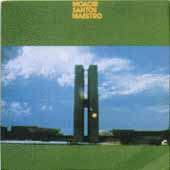
 O maestro, arranjador, instrumentista, compositor pernambucano Moacir Santos foi professor de Nara Leão, Baden Powell, Paulo Moura, Eumir Deodato, Airto Moreira, entre outros. Compôs, com Vinicius de Moraes, clássicos como "Triste de Quem", "Lembre-se" e "Se Você Disser Que Sim".
O maestro, arranjador, instrumentista, compositor pernambucano Moacir Santos foi professor de Nara Leão, Baden Powell, Paulo Moura, Eumir Deodato, Airto Moreira, entre outros. Compôs, com Vinicius de Moraes, clássicos como "Triste de Quem", "Lembre-se" e "Se Você Disser Que Sim".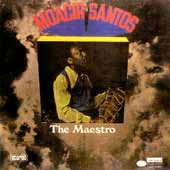
 In 1967, Santos left a solid career in his native country and moved to Southern California, where he recorded various phenomenal albums as a leader for the Blue Note label in the 1970s. Although he is regarded by the undersigned writer as one of the most innovative Brazilian jazz artists of all time, the author of Nana did not receive the recognition that he truly deserves until the year 2001, when the remarkable double CD Ouro Negro (Black Gold) was recorded in Rio, under the leadership of saxophonist Zé Nogueira and guitarist Mario Adnet, whose all-star team reproduced Santos' original arrangements, as written for the 28 instrumental pieces picked for the album. Compatible lyrics (penned by Ney Lopes) were added to some of the instrumental numbers, using some of the top Brazilian singers of our times (Milton Nascimento, Djavan, Joao Bosco, Gilberto Gil). In order to ensure the authenticity of the proceedings, Santos supervised the recording sessions, while contributing a few vocals, here and there.
In 1967, Santos left a solid career in his native country and moved to Southern California, where he recorded various phenomenal albums as a leader for the Blue Note label in the 1970s. Although he is regarded by the undersigned writer as one of the most innovative Brazilian jazz artists of all time, the author of Nana did not receive the recognition that he truly deserves until the year 2001, when the remarkable double CD Ouro Negro (Black Gold) was recorded in Rio, under the leadership of saxophonist Zé Nogueira and guitarist Mario Adnet, whose all-star team reproduced Santos' original arrangements, as written for the 28 instrumental pieces picked for the album. Compatible lyrics (penned by Ney Lopes) were added to some of the instrumental numbers, using some of the top Brazilian singers of our times (Milton Nascimento, Djavan, Joao Bosco, Gilberto Gil). In order to ensure the authenticity of the proceedings, Santos supervised the recording sessions, while contributing a few vocals, here and there.
 Br-Instrumental no Twitter
Br-Instrumental no Twitter




